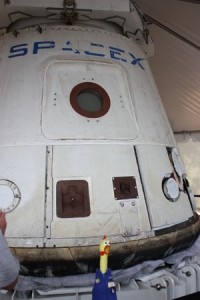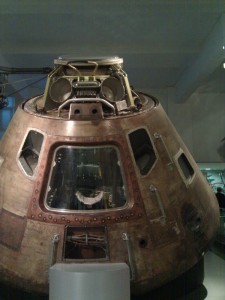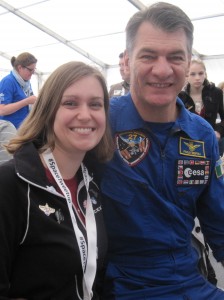Apr
28
Dear Science Museum… don't hide the star exhibit
I love the Science Museum in London. I always have, whether it was because it had lots of buttons to press as a child, because I learned they house Watson and Crick’s original model of the DNA double helix when I was thinking of studying genetics, or because they have adults-only evenings with interesting talks. I love it.
 Of course it was the first place I thought to go to learn about space before I had my first meeting with astronaut Leroy Chiao. A year ago I knew Apollo 11 went to the moon and that Apollo 13 was a film I hadn’t seen, about astronauts in trouble. I needed to know more than that before I sat down for lunch with an astronaut. (An astronaut!!!)
Of course it was the first place I thought to go to learn about space before I had my first meeting with astronaut Leroy Chiao. A year ago I knew Apollo 11 went to the moon and that Apollo 13 was a film I hadn’t seen, about astronauts in trouble. I needed to know more than that before I sat down for lunch with an astronaut. (An astronaut!!!)
I trawled a wikipedia page that introduced me to Mercury and Gemini. So much information. I needed to see things, be surrounded by them. I headed to the science museum. Like an eager schoolchild I entered the space gallery with my notepad and pen. I wanted to learn, to be educated, to be inspired.
I hate to say it, because I hold the Science Museum dearly close to my heart, but I was disappointed. There were boards telling kids that they could be astronauts, which I felt didn’t do justice to the gravity of all that entails. Why not encourage them to be engineers, rover drivers, software engineers.
Being an astronaut is cool, but not many people get to do it, and for a while at least, there aren’t going to be too many opportunities, not through traditional channels anyway. The display said that governments were all aiming for the moon, even back then I knew enough to know the that was no longer the case. NASA was in limbo, Constellation had just been axed, no-one knew quite what was coming next, but the moon wasn’t a prime target.
There were artifacts, but no overall feel for how they fitted into the story of space. There was a 1986 video of the shuttle, it looked embarrassingly dated. None of it felt sexy and spacey, and let’s not forget: Space IS Sexy.
I left having written down one date and the name of the first dog in space. Then I went home to read Wikipedia and panic about what exactly one should wear when meeting an astronaut.
Two weeks later I was back at the science museum to attend TEDx London. As I walked deep into the museum to the theatre I said an internal “hello” to the structure of DNA and then stopped in my tracks as I passed a thick wall and found an Apollo capsule. An ACTUAL been-in-space-and-come-back-again Apollo command module. Apollo 10 in fact.
Wow! A real Apollo capsule. I was excited, gleeful, inspired…
…and then annoyed.
How the hell could I have come to the Science Museum, specifically to learn about space, read pretty much every single word on every sign in the gallery in order to try to absorb something and STILL miss that they have an Apollo capsule?!
I had a feeling that I had missed something, that my childhood self had seen more, but I looked around and there was no sign of there being anything more about space in the museum.
Today I attended Science Museum Lates, a space themed one, and I got to ask the space section curator, Doug Millard, “Why?”.
What a travesty! It’s the only flown Apollo capsule that is not in the United States. It’s a massive honour that London has this at all. It’s an incredible piece of history. Not just space history, ALL history. It should be the centre piece of any exhibition about space. Without a doubt.
If I had my way I would put the Apollo 10 capsule SLAP BANG in the middle of the space exhibition. It is by far the most exciting piece in the collection. Not only has it been in space, it has been AROUND THE MOON! How can they justify hiding something like that? It is the real deal. It should be celebrated not tucked away.
Then again, if I had my way, I’d be getting ready to go to space right now (or at least to see another shuttle launch!), and I know I can’t always have things my way. My compromise, if one really *has* to be made, would be to put a whopping big “REAL Apollo Capsule THIS WAY” sign in the middle of the carpet to a) alert people to the fact they have one in the museum collection, and b) tell them where the f&%k it is. (I’m sorry to get all CAPS LOCK on you, but I’m really passionate about this.)
Space is Sexy. New space is sexy and exciting. I don’t understand how it is possible to have an entire exhibition so focused on the past, with out of date labels giving the impression that space was something that used to happen, and yet still tell children they can all be astronauts. How? How can they be astronauts?

Well maybe now would be a good time to introduce the idea that space is becoming more commonplace. Draw parallels with the beginning of the aviation industry. Mention exciting things like the Ansari X-Prize,SpaceShipOne, Virgin Galactic. What about the Google Lunar X-Prize? People are trying to send ROBOTS to THE MOON! That’s awesome! What kid wouldn’t be excited about that? Especially if they were told they could even join some of the teams competing for this multi-million dollar prize.
 What about commercial space? SpaceX‘s boss Elon Musk has announced they want to send people to MARS within the next two decades. They have engineers and programmers working their guts out right now to build the next generation of rockets. That is exciting. That is futuristic and cool. That is the future. That is what we should be using to inspire the next generation of scientists, mathematicians and engineers. The fact that real space stuff, is really happening, NOW.
What about commercial space? SpaceX‘s boss Elon Musk has announced they want to send people to MARS within the next two decades. They have engineers and programmers working their guts out right now to build the next generation of rockets. That is exciting. That is futuristic and cool. That is the future. That is what we should be using to inspire the next generation of scientists, mathematicians and engineers. The fact that real space stuff, is really happening, NOW.
There must be more that can be done. The European Space Agency has an astronaut (the lovely Paolo Nespoli) in space right now, he’s on Twitter. Even just putting a screen up with a loop of photos he’s sent down from space, beside his tweets, that would be an amazing way to start making people realise this stuff is real. He’s up there right now. I wave at him when the ISS passes overhead. Things don’t need to cost a fortune.
Hell, I will loan the museum my space artifacts if it means that more people can enjoy them and be inspired by them. I have seen amazing things, I’ve been lucky enough to visit space centres and US aviation/space museums, I *know* there is more that can be done.
So I’m making my pledge right here, right now. I am going to do all that I can to improve the space section of the Science Museum in London. I will pull every string, of every contact, and go out and make more contacts if I need to, so that I can do all that I can to help. Who’s with me? Who can help?
Comments rescued from internet caches of the original version of this site, that was lost – cry!
8 Responses to “Dear Science Museum…don’t hide the star exhibit”
Matt says:
April 28, 2011 at 6:40 amReplyIt’s crazy- CRAZY- not to put the capsule front and center. It’s *SO* cool that they have one. How– how do you not? Insane. Jeebus.It’s tragic that it’s so expensive to set new exhibits up. It seems like something like Constellation information could be updated and maintained by volunteers – a good first target for you.
If there’s any SpaceX gear that can help your quest (patches or whatnot), let me know. I can try get some for you.
Paul says:
April 28, 2011 at 1:55 pmReplyI love this Kate. Love it. Agree with you entirely. I revisited the Science Museum last summer (one of the Lates, too!) having not been since I was a kid – when I used to love it. I even bunked off secondary school once, to go to the Science Museum. My dad didn’t believe me when I told him that’s where I went, and threatened to give me a hiding until I showed him my admission ticket. I bet he was disappointed!I digress.
I feel exactly the same as you – here we have this incredibly unique object: not a model, not a mock-up, or some insignificant piece of a larger thing. It’s a bloody space capsule! A real, bona fide Apollo space capsule that, as you say, has been not just *into* space, but around the moon. And if that stuff isn’t sexy enough, it also housed the real people who did the mission. It’s been through re-entry! Splashed down in the ocean! I just..!
I don’t know what to add to your thoughts, I just wanted to put my hand up and say “bloody hell, THIS!” and point at your post.
rcamp004says:
April 28, 2011 at 2:48 pmReplyKate, I can’t thank you enough for writing this piece. I’ve been twice, and honestly I can’t remember if I saw it or not. I’d like to think I did.WHY ISN’T THIS FRONT AND CENTER?
Does the curator even know this is in the museum? I would like to think this was an error of ignorance rather than one of planned stupidity.
The museum is practically built in to Imperial College – what about the Aero engineers that are missing out on this marvel? The public would go in droves if they advertised it enough!
This is, in fact, part of the reason why the public is indifferent about space, and this kind of error causes the loss of countless future engineers, scientists, mathematicians, doctors, and every other profession with roots tracing back to STEM.
An action like this from the museum actually aids in the decline of society, and is counter to the missions and goals the science museum dreams of accomplishing.
Give ‘em hell, Kate!
Angie says:
April 28, 2011 at 9:14 pmReplyI absolutely love your enthusiasm! As an engineer (and space enthusiast as well), I often work with schools to get students excited about STEM (science, technology, engineering, and math). The comment is often made that we need another “space race” to get kids charged up again about the awesomeness of being an engineer.I whole-heartedly agree with you that our museums need to feature exciting ways, other than just astronaut, to be involved in the space industry! This would help propel the space industry as well as STEM education.
Maybe Space Museum curator is your new calling?! Supporting you all the way!
Megan Lucassays:
April 28, 2011 at 9:30 pmReplyCouldn’t agree more. I’ve been going to see that little craft for over 30 years now, every time I’m in South Kensington or even just London and I have a few moments to spare I pop by to see it. I may take it for granted these days but it does need to be sung from the rooftops.We may not be getting a Shuttle Orbiter, but we still have something amazing.
DLG says:
April 30, 2011 at 12:35 amReplyAgree wholeheartedly with the sentiment. It’s eighteen months or so since I was last there, but I was struck by the dated nature of the space exhibits. It’s a critical area of modern technology undergoing disruptive change RIGHT NOW, and more thought should be given as to how a museum exhibit can reflect that.This might spur me to get back in touch with my local musem, the National Space Centre. I did work with some NSC staff a few years back on developing a space tourism exhibit, but that kind of petered out as the people I worked with moved on.
Keep up the good work. You’re doing what I wish I could do, if I didn’t have to keep up the regular 9 to 5
Duncan, Rocketeers editor (http://www.rocketeers.co.uk/)
Malcolm Smith FBIS says:
May 3, 2011 at 5:36 amReplyHi Kate: Have you contacted the BIS with regard to this? (Sorry if you have and you mentioned this elsewhere – I am bowed down with work and home life pressure at the mo, so cannot devote as much time to my passion for real space exploration at present as I’d like.) In fact I think Doug Millard is on the BIS’s History Committee…Also this might be of interest to you:
Carl Wilsonsays:
May 3, 2011 at 2:35 pmReplyHello Space Kate,Hi, I agree wholeheartedly with your comments and those of others on this subject. I seem to remember that back in the early 90s (when I lived and worked closer to London and the science museum was a frequent weekend haunt) The Apollo capsule was more of a centre piece. I visited South Kensington last year for the first time in many years, and found it much changed. I found the space and rocketry display quite uncoordinated and half hearted. Whilst they have several good examples of motors and other hardware, there was little to tell visitors how it all interacted and fitted in with the big picture…the Apollo capsule in the centre of it all would have been a massive clue. That said I was gratified to see the only example left of the British satellite launch vehicle, the Black Arrow R4 rocket. The R3 launched the satellite “Prospero” in 1971.
Now, I have a theory…As you say Kate, spaceflight and all the attendant stuff is sexy. At least to the likes of us. The one thing it isn’t is *green*. And therein lies the rub. Anything today in scientific or technical endeavour that is not related to returning us all to the dark ages, scratching a living from the ground or eking out meagre electrical supplies from inefficient wind turbines is seen as in some way wrong or bad.
Space hardware, especially, is seen as polluting, noisy and possibly slightly dangerous. Belching huge flames and filled with all kinds of nasties like monomethylhydrazine. Nasa themselves felt constrained in the late 90s to remove this particular substance from the shuttle. It was used in the reaction control system and they went over to “greener” ethanol and LOX.
Obviously I don’t want to see the earth ravaged and ruined. What I do want to see is a lot more celebration of engineering and scientific endeavour that embodies the best the human spirit has to offer; questing into the unknown and striving for greater heights. When I started school in 1975 I was confronted with a 6ft high collage of an astronaut in space that the class had made. The image of it has stayed with me to this day. Back then the moon landings were still talked about in hallowed tones, the US had Skylab, our own supersonic transport aircraft were at the testing stage, and Britain had launced its own satellite. Sadly, it seems, these days the future is in the past.



